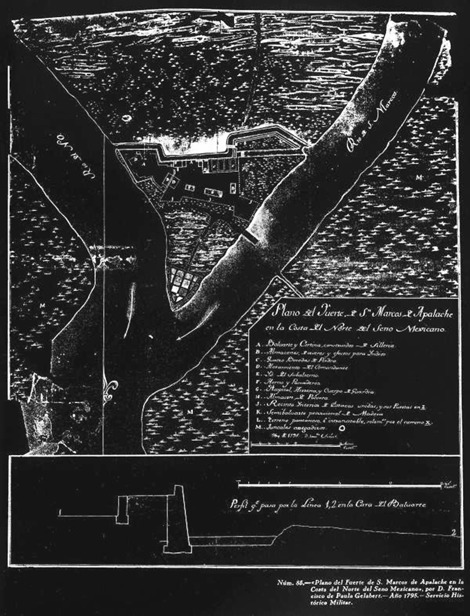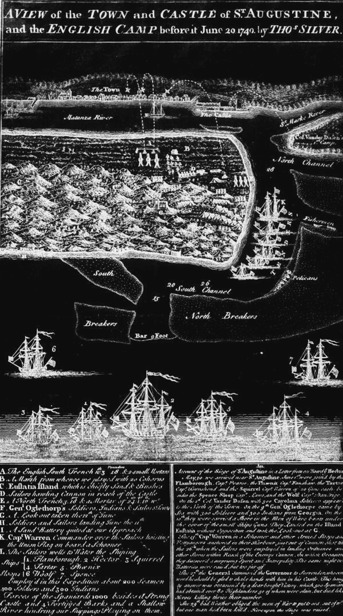The History of Florida (25 page)
Read The History of Florida Online
Authors: Michael Gannon
Tags: #History, #United States, #State & Local, #Americas

aged them to attack the Westoes. The enslaved Indians captured during
these raids were purchased by the English and put to work on plantations
or sold to planters in the Caribbean islands.
These tactics had direct impact on Spanish Florida. Apalachicola and
Yamassee armed by English traders attacked the villages of Christian Indians
at Franciscan missions among the Guale along the Georgia coast, enslaving
captives and forcing survivors to relocate to sites farther south and closer
to St. Augustine. Attacks next focused on the Timucua and the Apalachee.
Within two decades of their arrival at the Ashley River, Carolina traders had
moved west from Charleston and drawn into their trade network the Native
Americans located north of Florida and to the west as far as today’s central
Alabama. They had also formed alliances with Native Americans that posed
a serious threat to the continuation of Spanish Florida.
This threat to La Florida overlapped with a chal enge from French ex-
plorers who were expanding from Quebec through the Great Lakes and
down the Mississippi River to the Gulf of Mexico staking territorial claims
Raids, Sieges, and International Wars · 115
for future settlements. In 1699, Pierre le Moyne, Sieur d’Ibervil e, led an
expedition from France to establish a colony on the Gulf coast at Pensacola
Bay. When he arrived, he discovered that Spaniards were already building a
fort in a belated attempt to maintain control of the Gulf and protect Span-
ish settlements at Mexico. Ibervil e instead established Fort Maurepas at
Biloxi Bay and Fort Mississippi, south of today’s New Orleans. His goal was
to control the Mississippi River delta and block access to ships from other
European nations. From the French colony of Louisiana, traders established
partnerships with Chickasaw, Choctaw, and other Native Americans in the
vicinity, and proceeded upriver to strike similar partnerships along the nu-
merous rivers feeding into the Mississippi.
With a dynamic French presence to the west at Louisiana and an aggres-
sive and an expanding English colony to the north at Carolina, the residents
of Spanish Florida were placed in a precarious position. To strengthen its
controls, Spain authorized construction of a stone fort at St. Augustine, the
Castil o de San Marcos, and to protect the Apalachee missions and their
vital agricultural resources, the Castil o de San Marcos de Apalachee was
built in 1680 on the St. Marks River, inland from Apalachee Bay (thirty miles
south of Tal ahassee in Wakul a County). In 1696, a two-story blockhouse
with artillery and a palisade was built at Mission San Luis (in present-day
proof
Tal ahassee).
A European conflict, the War of Spanish Succession (1701–14), known
in the North American colonies as Queen Anne’s War, brought devasta-
tion to Spanish Florida. Fear that the balance of power would be upset if
the thrones of France and Spain merged following the death of Charles II
of Spain and his succession by Philip V, the grandson of the king of France,
led to a major European war. France and Spain faced off against England,
Austria, the Netherlands, and Prussia. In North America, Governor James
Moore of Carolina was determined to destroy Spain’s Florida colony and
fol ow that with an attack on the French in Louisiana. The first blow was
struck in May 1702 by Creek warriors who burned Mission Santa Fe on
the road from St. Augustine to Apalachee, and carried off Timucuan cap-
tives as slaves. In the failed Spanish counterattack that followed, the Creek
killed or captured more than 400 Timucuan and Apalachee auxiliaries of
the Spanish.
In November 1702, Governor Moore led a force of 1,200 men, primarily
Creek warriors, against the Spanish at St. Augustine. Detachments under
Colonel Robert Daniel debarked first at Amelia Island and destroyed the

116 · Daniel L. Schafer
proof
Castillo de San Marcos de Apalachee. The site of this fortification was inland from
Apalachee Bay on the St. Marks River. The site can be visited at San Marcos State Park,
off State Road 363 in Wakulla County, Florida, 30 miles south of Tallahassee. Courtesy
of the National Archives, Kew, England.
missions and vil ages there. San Juan del Puerto at Fort George Island and
Piritiriba, located south of the St. Johns on the west bank of the San Pablo,
were destroyed next.
Governor Moore had proceeded by water to St. Augustine Inlet to block
entrance to the harbor and join with Colonel Daniel’s men, who arrived on
November 10 and established headquarters at the south of town near the
convent on St. Francis Street. Spanish Governor Joseph de Zúñiga y Zerda
had already moved 1,500 town residents, soldiers, refugees, and stores of

proof
A View of the Town and Castle of St. Augustine, and the English Camp
before it, June 20, 1740. General Oglethorpe and the British invaders
from Georgia were unable to breach the walls of the Castillo de San
Marcos and called off the siege of the Spanish town. By Thomas Silver.
Courtesy of the University of Florida Digital Collections, http://ufdc.ufl.
edu/UF90000078/00001.
118 · Daniel L. Schafer
corn inside the Castillo. He also arranged for soldiers to round up a herd of
160 cattle and drive the thundering beasts through the streets of the town.
Startled English troops ran for cover as the cattle ran across the drawbridge
over the moat. Behind the protective stone wal s of the Castillo de San Mar-
cos, the Spaniards waited anxiously, praying for the arrival of a relief force
from Havana.
Unable to breach the wal s of Castillo de San Marcos, Moore laid down a
siege expecting to starve the inhabitants into submission. The Spanish relief
force that arrived from Cuba on December 26 trapped the Carolina ships in
the harbor and forced Moore to end the siege. His men torched their vessels
and ignited a conflagration in the town that destroyed religious and govern-
mental structures and left only twenty houses standing, along with Nuestra
Señora de la Soledad, built in 1572, and the hospital attached in 1597, the
first hospital in continental United States. The English invaders marched
northward, leaving more charred ruins in their path. At the entrance to the
St. Johns they boarded English ships and returned to Charleston in disgrace.
In November 1703, former governor James Moore was offered a chance
to redeem his reputation by leading fifty Carolina settlers and 1,000 Lower
Creek and Yamassee in an invasion of Apalachee province. A census of thir-
teen Apalachee missions compiled in 1689 by the bishop of Cuba, Diego
proof
Ebelino de Compostela, listed nearly 10,000 residents. Between January and
August 1704, the Apalachee, the Spanish friars and soldiers, and floridano
ranchers and farmers were swept away in attacks by Moore’s Carolina mi-
litia and al ied Creek and Yamassee warriors. Between January and April
1704, Moore’s army swept through Apalachee, destroying vil ages, killing or
enslaving as many as 2,000 Apalachee converts to Christianity, and force-
ful y persuading between 1,300 and 2,000 Apalachee to follow his army to
Charleston to avoid death or enslavement. Only the seven mission vil ages
whose leaders paid ransoms to Moore remained after the invaders departed.
After Creek warriors raided Apalachee again in June and July, only the
vil ages at San Luis, Ivitachuco, and Chacato remained. Spanish authori-
ties in St. Augustine recognized it would be futile to resist further attacks
and abandoned the Apalachee missions. A group of 800 Apalachee from
San Luis decided to march westward to join the French at Mobile, while
many more abandoned the Spaniards and migrated north and west to merge
their families into Creek vil ages along the Apalachicola, Flint, and Chat-
tahoochee Rivers. Patrice de Hinachuba, the leader of Ivitachuco, led his
vil agers eastward to Potano and established the new settlement of Abosaya
near the La Chua cattle ranch. But the Creek raids continued, focused on
Raids, Sieges, and International Wars · 119
Yustaga, Potano, and the ranch at La Chua. The new town of Abosaya was
attacked, forcing the survivors to seek safety in smal settlements outside the
town wal s at St. Augustine.
Governor Zúñiga y Zerda ordered other mission vil ages and stockades
rebuilt in the aftermath of the Carolina raids of 1702 and 1704, including at
San Francisco Potano and at the La Chua cattle ranch. As a result of hostile
Indian raids, all the new vil ages were destroyed or abandoned soon after
they were completed. In
A
History
of
the
Timucua
Indians
and
Missions
, John Hann describes an anonymous and undated map of Piritiriba dated
circa 1704 that indicates a “four-bastioned fort” with “barracks, living quar-
ters, and warehouses for supplies” was constructed—possibly as early as
1703—to protect two adjoining vil ages of refugee Guale and Mocama. Ap-
parently, San Juan del Puerto was not rebuilt. Each vil age at Piritiriba had
its own church, but prayers did not protect them from attacks that resulted
in the death and capture of 500 Indians.
Governor Córcoles y Martínez estimated that, between 1702 and 1708,
more than 10,000 Native Americans perished, yet the Creek and Yamassee
attacks continued. Even the Indian vil ages outside the wal s of St. Augustine
were attacked. Without supplies of corn and beef formerly supplied by the
Guale, Timucua, and Apalachee, St. Augustine residents were dependent on
proof
imports by water. Severe shortages and hungry times lay ahead.
In 1715, it was the Carolina colonists who were attacked by Native Ameri-
cans, this time by a confederation led by Yamassee warriors angered by Eng-
lish encroachment. More than 400 settlers were kil ed before the English
regained control, which prompted several hundred Yamassee to take refuge
with the Spanish at St. Augustine. Others who participated in the rebel-
lion migrated to Creek vil ages along the Apalachicola and Chattahoochee
Rivers.
It was to these vil ages that Lt. Diego Peña and a detachment of Span-
ish soldiers traveled in 1717 to promote trade opportunities and to encour-
age the residents to migrate to the abandoned fields formerly tilled by the
Apalachee. In support of Lt. Peña’s initiatives, the fort at St. Marks was re-
built to facilitate trade with St. Augustine and Havana. Eventual y, Creek
migrants began moving into the rolling hil s region near today’s Tal ahas-
see, but the more aggressive diplomatic and trade initiatives by the English
minimized Spanish gains.
Between 1723 and 1728, the English waged persistent war on the Yamas-
see, relentlessly destroying their vil ages along the Apalachicola and Chatta-
hoochee Rivers, as wel as in Apalachee and near St. Augustine. An epidemic
120 · Daniel L. Schafer
at St. Augustine in 1727 claimed the lives of approximately 500 Yamassee,
and more lives were lost due to a raid on Mission Nombre de Dios led by
Colonel John Palmer of Charleston in March 1728.
The next major threat to the continuation of Spanish Florida came in 1732
with the establishment of the English colony of Georgia in the disputed ter-